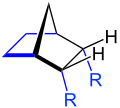endo - exo isomerism
In organic chemistry, endo - exo isomerism is a special form of isomerism that only occurs in substituted, bridged bicyclic hydrocarbons . The terms endo and exo are relative stereodescriptors and are now only used in systematic names for achiral pseudo-asymmetric stereogenic centers on the framework of bicycloalkanes and bicycloalkenes and their heteroanalogues.
The isomer in which the substituent R is on the opposite side of the shortest bridge ( marked in green ) is called endo ( endo , Greek, inside) . The term exo ( exo , Greek, outside) denotes the isomer in which the substituent R is on the side of the shortest bridge:
The endo - exo isomerism can be easily recognized using structural formulas:
This bicycle has three bridges: Two each with 2 carbon - atoms , and one with a carbon atom (peak top). The residues R can therefore occupy two different positions on the one "two-carbon bridge" :
- if they are on the same side as the other “two-carbon bridge” marked in blue , this corresponds to an endo position of the R radicals in the bicycle.
- if they are on the opposite side to the other ( blue marked) “two-carbon bridge”, this corresponds to an exo position of the radicals R in the bicycle.
Bicycles that are simply substituted on the shortest bridge cannot be described with the endo-exo definition. These isomers are classified using the syn - anti notation .
Web links
- Entry to endo, exo, syn, anti . In: IUPAC Compendium of Chemical Terminology (the “Gold Book”) . doi : 10.1351 / goldbook.E02094 Version: 2.3.3.
Individual evidence
- ^ Bernhard Testa: Fundamentals of Organic Stereochemistry , Verlag Chemie, Weinheim, 1983, pp. 128–130, ISBN 3-527-25935-X .



